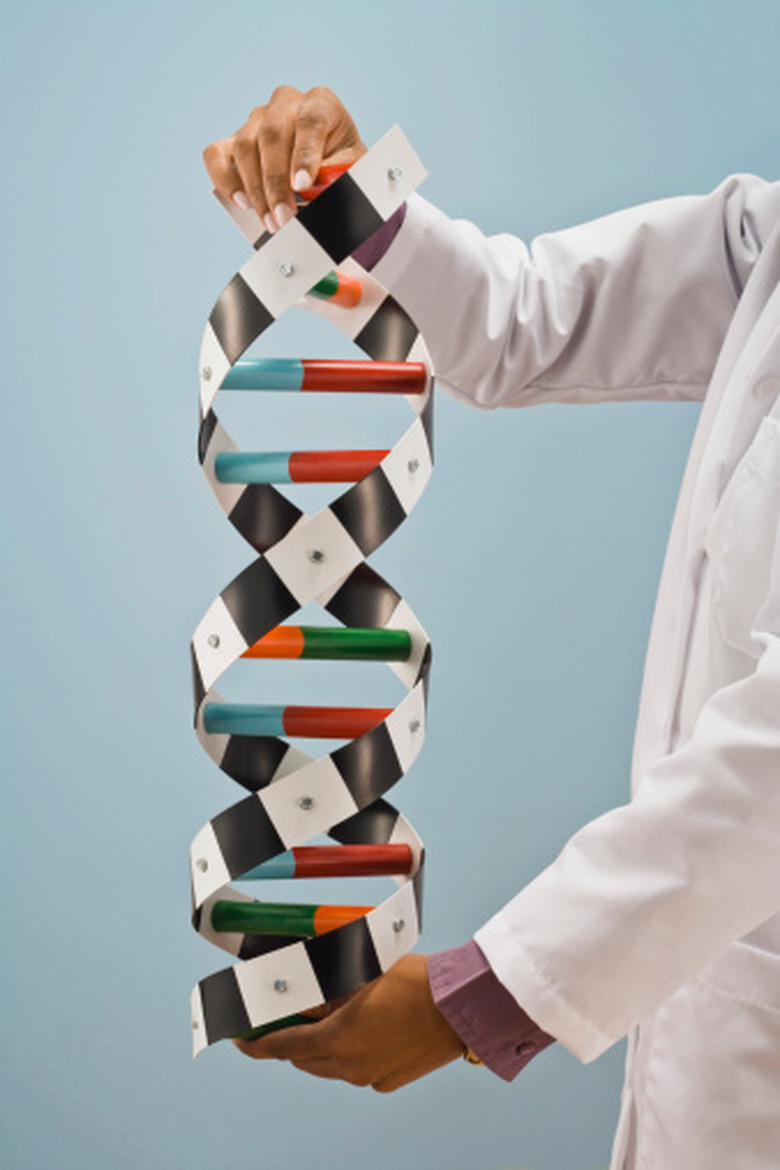Ideas For Making A 3-D DNA Stand For High School
Building models to better visualize concepts has a long tradition in science. The double helix of a DNA molecule might be the most iconic. To build your own 3-D DNA model worthy of a high school classroom, it helps to know your subject. Armed with this knowledge and these suggestions, you can put together a 3-D DNA with ease, even if you have never built a model before.
Meet DNA
Meet DNA
For purposes of a DNA model, you need at least two basic materials: the outer strands and the inner base pairs. The two parallel strands, in reality made of phosphate and sugar, are far longer than the short nitrogenous bases adenine, thymine, guanine and cytosine, commonly referred to by the initials A, T, G and C. The bases "pair up" inside the long strands — T always with A and C always with G — like rungs on a twisted ladder.
Decide How Accurate
Decide How Accurate
DNA has millions of base pairs, so a scale model seems ambitious. Real DNA twists back and forth inside a chromosome, but most models stretch out a section, making it easier to see. Also, the structure of DNA is self-supporting in the liquid of cells. Some models use a center column to hold the base pairs, which hold the twisting strands. For a truer model, eliminate the column.
Supplies You Have at Home
Supplies You Have at Home
Gather cdommon household items to build your model. Twist aluminum foil into long strands and tuck small pieces in the folds for the base pairs. Tie short pieces of string, twine or yarn together and tie those between longer pieces. You can use building toys to create a DNA model because many pieces will connect to each other. Try toothpicks, fabric, drinking straws, wires and paper; combine different materials for interest and structure.
Purchased Supplies
Purchased Supplies
To make a rigid model, PVC does not need to be glued to remain together. For a flexible model, soft plastic tubing would make a good outer strand — make slits in the tubes and force the head of a bolt in like through a buttonhole. Use nuts to hook the bolts together. If you are handy with wood, use veneer for the strands and glue small pieces of pine for the base pairs. DNA functions like a zipper, so find a big one at the fabric store.
Finishing Touches
Finishing Touches
Ideally, code the A/T and C/G pairs. Use four different color yarns, or paint a single material with two colors per rung. If the structure you create does not stand alone, consider using fishing wire to hang it from the ceiling. For added effect, place your model inside a large clear jug filled with water, and tie the model to the lid so it floats. If your first idea does not work, do not be discouraged. Use what you learned in the first try to make an even better 3-D model of DNA.
References
Cite This Article
MLA
Perez, Christopher. "Ideas For Making A 3-D DNA Stand For High School" sciencing.com, https://www.sciencing.com/ideas-dna-stand-high-school-8319125/. 24 April 2017.
APA
Perez, Christopher. (2017, April 24). Ideas For Making A 3-D DNA Stand For High School. sciencing.com. Retrieved from https://www.sciencing.com/ideas-dna-stand-high-school-8319125/
Chicago
Perez, Christopher. Ideas For Making A 3-D DNA Stand For High School last modified March 24, 2022. https://www.sciencing.com/ideas-dna-stand-high-school-8319125/
